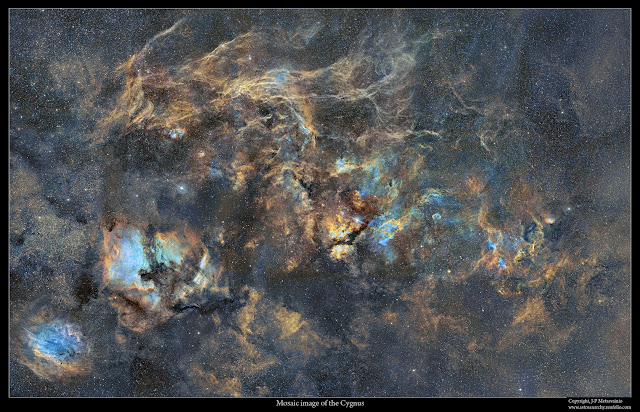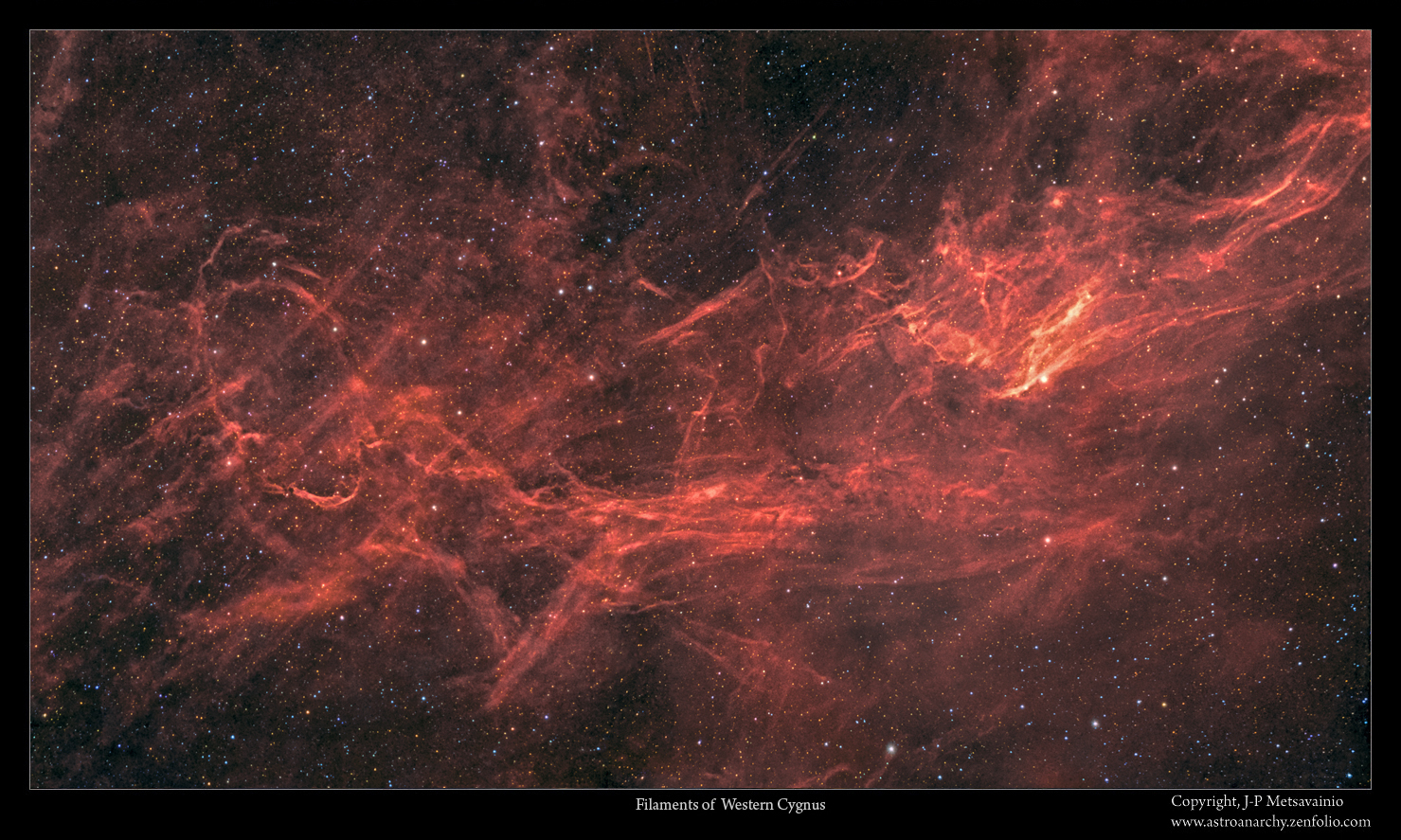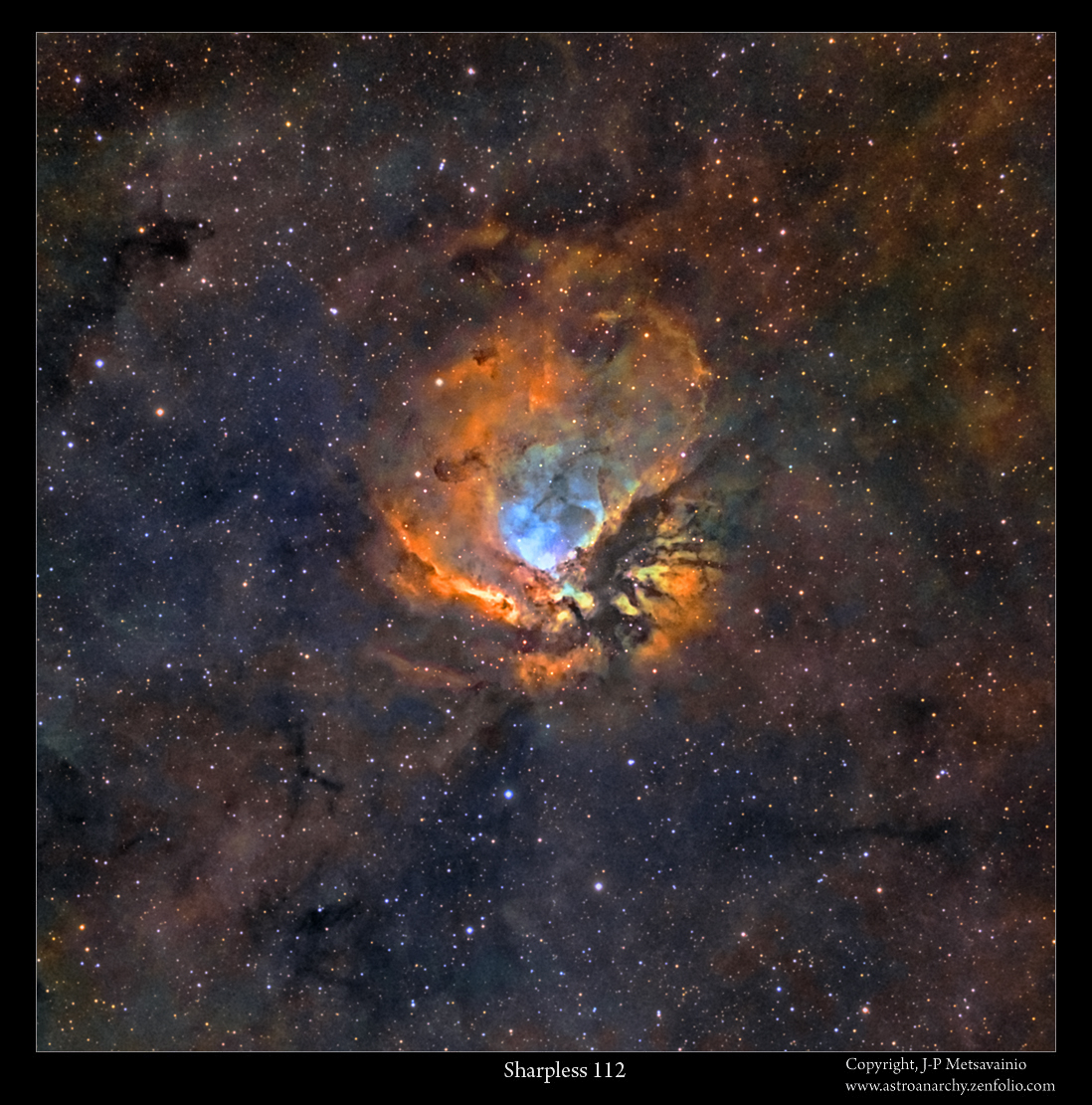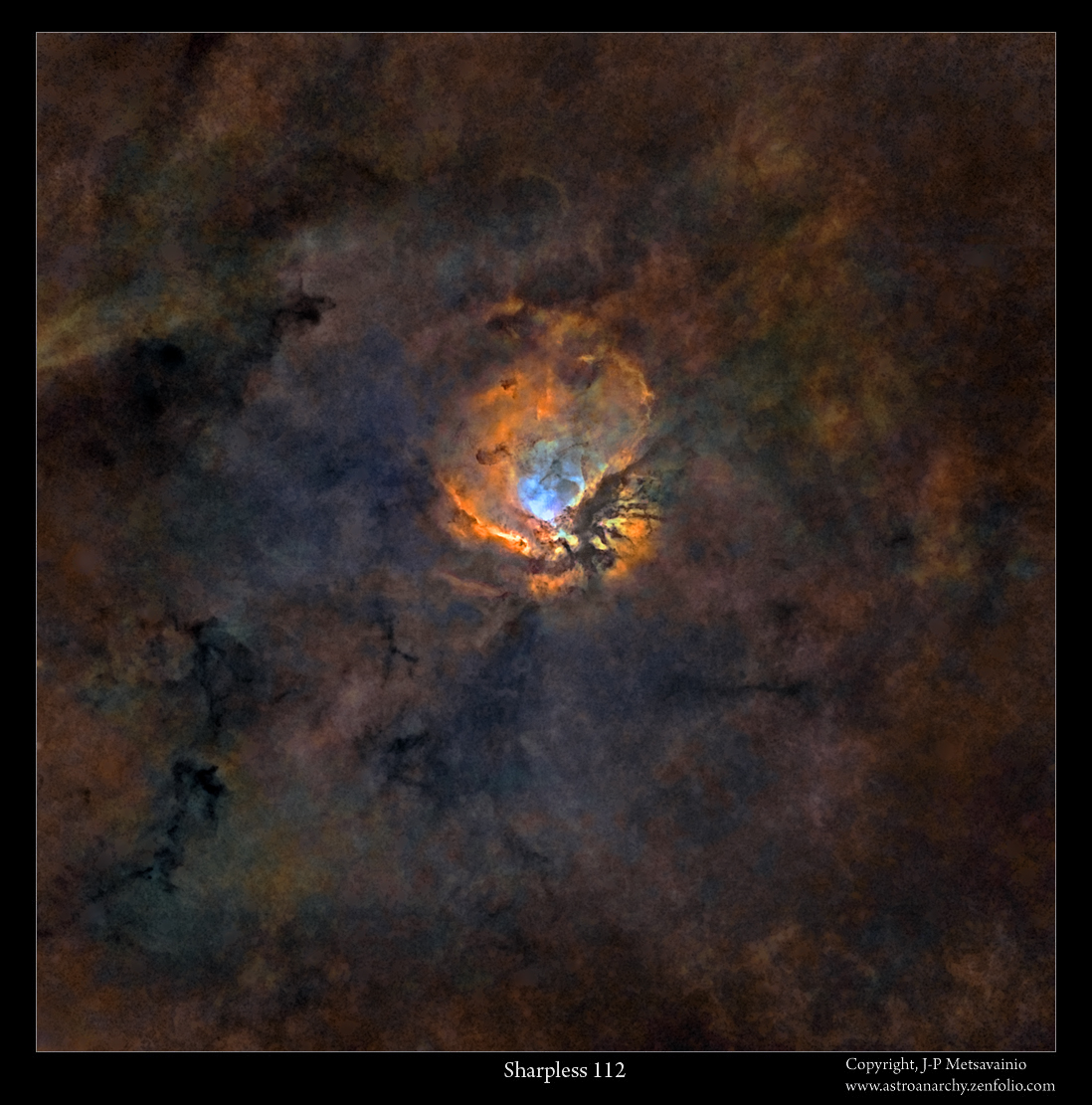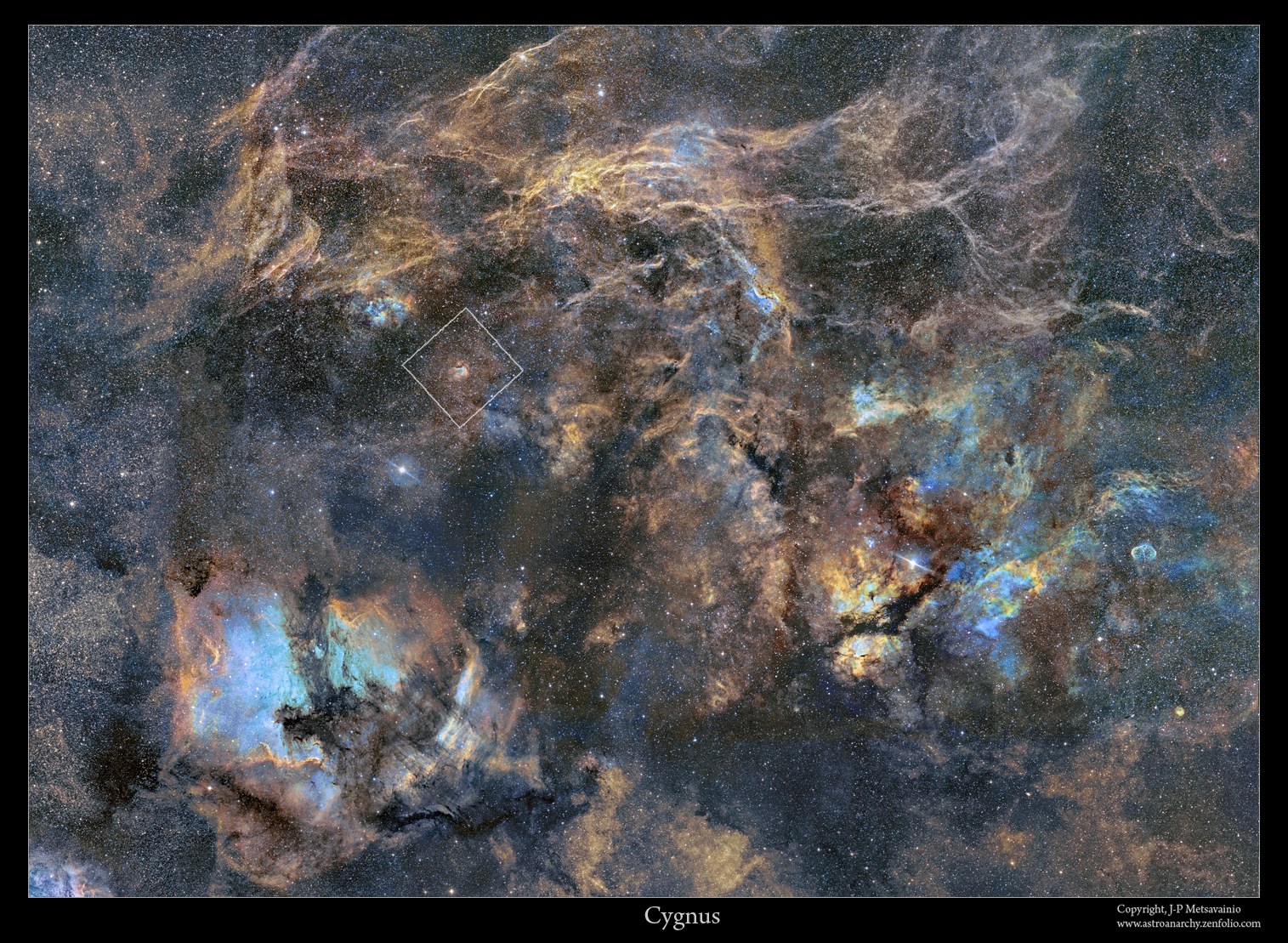COPYRIGHT, PLEASE NOTE
All the material on this website is copyrighted to J-P Metsavainio, if not otherwise stated. Any content on this website may not be reproduced without the author’s permission.
Have a visit in my portfolio
PORTFOLIO:https://astroanarchy.zenfolio.com/
Saturday, October 31, 2015
Filaments of the Western Cygnus
I have spent some clear nights by shooting dim gas structures in Western part of the nebula rich constellation Cygnus. This area of Cygnus is not commonly imaged due to low surface brightness and close proximity of more eye catching nebulae. My previous project of Western Cygnus can be seen in this blog post.
This time I shot a formation around the magnitude 3,96 star, OMI02 Cygni. It can be seen as a most brightest star at middle right. This is a two frame mosaic image.
Filaments of Cygnus
Please, click for a large image
Filaments of glowing gas around the star OMI02 Cygni. Image is in mapped colors from the light emitted by the ionized elements. Red=Sulfur, Green=Hydrogen and Blue=Oxygen.
Filaments of glowing gas around the star OMI02 Cygni. Image is in mapped colors from the light emitted by the ionized elements. Red=Sulfur, Green=Hydrogen and Blue=Oxygen.
An experimental starless version
Please, click for a large image
In this starless version the gas filaments can be seen better. (I let a one star for a compositional reasons.)
Image in visual spectrum
Please, click for a large image
Natural color composition from the emission of ionized elements.
Natural color composition from the emission of ionized elements.
This palette is very close to a visual spectrum.
Images in this post are a small part of the Cygnus nebula complex
Please, click for a large image, 2200 x 1400 4,2MB
Technical details
Processing work flow
Image acquisition, MaxiDL v5.07.
Stacked and calibrated in CCDStack2.
Deconvolution with a CCDStack2 Positive Constraint, 21 iterations, added at 25% weight
Color combine in PS CS3
Levels and curves in PS CS3.
Imaging optics
Celestron Edge HD 1100 @ f7 with 0,7 focal reducer for Edge HD 1100 telescope
Canon EF 200mm f1.8 lens
Mount
10-micron 1000
Cameras and filters
Imaging camera Apogee Alta U16 and Apogee seven slot filter wheel
Guider camera, Lodestar x2 and SXV-AOL
QHY9 for S-II and O-III emsissions
Astrodon filter, 5nm H-alpha
Baader O-III
Baader S-II
Exposure times
H-alpha, 24 x 1200s = 8h
O-III, 8 x 600s = 1h 20min.
S-II, 8 x 600s = 1h 20min.
Total 10h
Labels:
Narrowband color images,
nebula
Thursday, October 29, 2015
Filaments of Cygnus, project continues
At night of 27. October I managed to shot some new lights for this interesting area in the Western Cygnus. Speeding clouds ruined most of my imaging session but I got just enough exposures to make this two frame mosaic. At some point, I'll shoot more data for O-III and S-II, at the moment the signal is extremely low. I got it processed by using the powerful Tone Mapping v2 workflow.
Filaments of Cygnus, a two frame mosaic
Red=Sulfur, Green=Hydrogen and Blue=Oxygen.
A starless view
Image in visual spectrum
Please, click for a large image
This palette is very close to a visual spectrum.A starless view
Please, click for a large image
Complex structures of the ionized gas stands out nicely in this experimental starless view.
Complex structures of the ionized gas stands out nicely in this experimental starless view.
Closeups
Please, click for a large image
Ring Of Fire
Please, click for a large image
Image description
Love is a burnin' thing,
And it makes a fiery ring
Bound by wild desire
I fell into a ring of fire.
I fell into a burnin' ring of fire
I went down, down, down
And the flames went higher,
And it burns, burns, burns,
The ring of fire, the ring of fire.
(Johnny Cash - Ring Of Fire, Lyrics by June Carter )
INFO
I noticed this ring back at November 2011. At the time I was shooting a less known area at the Western Cygnus. This looped gas formation got my attention. The "Cirrus of Cygnus" was a small part of the large mosaic image of the Cygnus nebula complex.
Few days ago, I got an email from Sakib Rasool. He told me, that a French astrophotographer Pascal Le Dû has reported this as a new planetary nebula or supernova remnant candidate, Du 2. More info here: http://www.cielocean.fr/index.php?page=ldu2
Here is an animation from November 2011, I made it to get a better view to this formation.

Few days ago, I got an email from Sakib Rasool. He told me, that a French astrophotographer Pascal Le Dû has reported this as a new planetary nebula or supernova remnant candidate, Du 2. More info here: http://www.cielocean.fr/index.php?page=ldu2
Here is an animation from November 2011, I made it to get a better view to this formation.

Image was taken at November 2011. I removed the stars to see the actual nebula better.
Canon EF 200mm f1.8 optics, QHY9 astro camera and Baader narrowband filters.
Images in this post are a small part of the Cygnus nebula complex
Please, click for a large image, 2200 x 1400 4,2MB
A 18-panels narrow band mosaic of the constellation Cygnus overlaid with Cartes Du Ciel screenshot.. Area of interest can be seen at about eleven o'clock position in this image as a blue regtangle.
Technical details
Processing work flow
Image acquisition, MaxiDL v5.07.
Stacked and calibrated in CCDStack2.
Deconvolution with a CCDStack2 Positive Constraint, 21 iterations, added at 25% weight
Color combine in PS CS3
Levels and curves in PS CS3.
Imaging optics
Celestron Edge HD 1100 @ f7 with 0,7 focal reducer for Edge HD 1100 telescope
Mount
10-micron 1000
Cameras and filters
Imaging camera Apogee Alta U16 and Apogee seven slot filter wheel
Guider camera, Lodestar x2 and SXV-AOL
Astrodon filter, 5nm H-alpha
Astrodon filter, 3nm O-III
Astrodon filter, 3nm S-II
Exposure times
H-alpha, 24 x 1200s = 8h
O-III, 4 x 1200s binned = 1h 20min.
S-II, 4 x 1200s binned = 1h 20min.
Total 10h
Labels:
Narrowband color images,
nebula
Thursday, October 22, 2015
Sharpless 112, Sh2-112, in Cygnus
Sharpless 112 is not a very commonly imaged target since the constellation Cygnus has so many eye catchers around. I shot this object at 29.9. but got it processed just now. There is an other Sharpless catalog object just few degrees from Sharpless 112, the Sh2-115. (I shot the Sharpless115 about a year ago, it can be seen HERE.)
Sh2-112
Image in mapped colors from the light emitted by ionized elements.
Red=Sulfur, Green=Hydrogen and Blue=Oxygen.
A closeup
Image in visual spectrum
Natural color composition from the emission of ionized elements.
This palette is very close to a visual spectrum.
Sharpless 112, Sh2-112, locates in constellation Cygnus at distance of about 6000 light years. My photo spans about one square degrees of sky. An apparent size of Sh2-112 is about 50% of the full Moon's angular size.
An experimental starless image
The actual nebula is easier to observe in this starless version
Orientation in Cygnus
Part of the 18-panels mosaic image of the constellation cygnus. Sh2-112 in a white rectangle.
Technical details
Processing work flow
Image acquisition, MaxiDL v5.07.
Stacked and calibrated in CCDStack2.
Deconvolution with a CCDStack2 Positive Constraint, 21 iterations, added at 25% weight
Color combine in PS CS3
Levels and curves in PS CS3.
Imaging optics
Celestron Edge HD 1100 @ f7 with 0,7 focal reducer for Edge HD 1100 telescope
Mount
10-micron 1000
Cameras and filters
Imaging camera Apogee Alta U16 and Apogee seven slot filter wheel
Guider camera, Lodestar x2 and SXV-AOL
Astrodon filter, 5nm H-alpha
Astrodon filter, 3nm O-III
Astrodon filter, 3nm S-II
Exposure times
H-alpha, 10 x 1200s = 3h 20min.
O-III, 4 x 1200s binned = 1h 20min.
S-II, 4 x 1200s binned = 1h 20min.
RGB for stars, 20min. each
Total 7h
A single uncropped, calibrated and stretched 20 min. H-alpha frame as it comes from the camera
Labels:
Narrowband color images
Monday, October 19, 2015
Filaments of Cygnus, "Ring Of Fire"
Start of the new imaging project, data is shot at October 7, Since the sky seems to be permanently cloudy now, I made this photo with the data I have. New exposures are 5h of H-alpha and colors are taken from my older Cygnus mosaic from 2012. I will continue with this image, when weather permits.
I noticed this interesting looking formation back in Autumn 2012 when I was finalizing the large 18-panels mosaic of cygnus.
I noticed this interesting looking formation back in Autumn 2012 when I was finalizing the large 18-panels mosaic of cygnus.
The Ring Of Fire, a Cosmic Lasso
Ra 20 24 Dec +46 17, Click for a large imageLove is a burnin' thing,
And it makes a fiery ring
Bound by wild desire
I fell into a ring of fire.
I fell into a burnin' ring of fire
I went down, down, down
And the flames went higher,
And it burns, burns, burns,
The ring of fire, the ring of fire.
(Johnny Cash - Ring Of Fire, Lyrics by June Carter )
An experimental starless version
Click for a large image
Filaments of red glowing hydrogen stands out nicely in this starless version
A closeup
Click for a large image
Orientation in Cygnus
Click for a large image
Part of the 18-panels mosaic image of the constellation cygnus. Color data is from this photo.
New Info (Updated 25.10.2015)
I get contacted by Sakib Rasool, he wrote:
"I wanted to mention that this nebula is known and is catalogued as Du 2. It is a
supernova remnant or planetary nebula candidate that was discovered by the
French amateur astronomer Pascal Le Dû.
You can see more here: http://www.cielocean.fr/index.php?page=ldu2
A
lot of new planetary nebulae have been discovered by amateur astronomers in the
past five years."
My first observation of this object at November 2011
Image was taken at November 2011. I removed the stars to see the nebula better.
Canon EF 200mm f1.8 optics, QHY9 astro camera and Baader narrowband filters.
At the time I was shooting a less known area at the Western Cygnus. This looped gas got my attention.
The "Cirrus of Cygnus" was a small part of the large mosaic image of the Cygnus nebula complex.
Technical details
Processing work flow
Image acquisition, MaxiDL v5.07.
Stacked and calibrated in CCDStack2.
Deconvolution with a CCDStack2 Positive Constraint, 21 iterations, added at 25% weight
Color combine in PS CS3
Levels and curves in PS CS3.
Imaging optics
Celestron Edge HD 1100 @ f7 with 0,7 focal reducer for Edge HD 1100 telescope
Mount
10-micron 1000
Cameras and filters
Imaging camera Apogee Alta U16 and Apogee seven slot filter wheel
Guider camera, Lodestar x2 and SXV-AOL
Astrodon filter, 5nm H-alpha
Exposure times
H-alpha, 15 x 1200s = 5h
Colors are from an older wide field image of the area
Labels:
Narrowband color images,
nebula
Saturday, October 17, 2015
Elephant's Trunk Nebula in the IC 1396
New image of the IC 1396. I got this ready at October 7, just before I went to the Panhellenic Conference of Astronomy in Sparta, Greece.
Elephant's Trunk Nebula
Please, click for a large image
Image in mapped colors from the light emitted by ionized elements.
Red=Sulfur, Green=Hydrogen and Blue=Oxygen.
A closeup
Please, click for a large image
INFO
The elephant's Trunk nebula is a concentration of interstellar gas and dust in the star cluster IC 1396.
This ionized gas region locates in the constellation Cepheus about 2400 light years away.
This about twenty light years long formation is coursed by a stellar wind, radiation pressure, from a group of massive young stars.
An experimental starless image
Please, click for a large image
A starless version of the photo makes easier to see the actual nebula.
A pareidolia fun...
A gargoyle of the sky
An older wide field photo of the IC 1396 emission nebula.
Please, click for a large image
Elephant's Trunk Nebula at six o'clock position in this image from Autumn 2011, more info can be found HERE
Technical details
Processing work flow
Image acquisition, MaxiDL v5.07.
Stacked and calibrated in CCDStack2.
Deconvolution with a CCDStack2 Positive Constraint, 21 iterations, added at 25% weight
Color combine in PS CS3
Levels and curves in PS CS3.
Imaging optics
Celestron Edge HD 1100 @ f7 with 0,7 focal reducer for Edge HD 1100 telescope
Mount
10-micron 1000
Cameras and filters
Imaging camera Apogee Alta U16 and Apogee seven slot filter wheel
Guider camera, Lodestar x2 and SXV-AOL
Astrodon filter, 5nm H-alpha
Astrodon filter, 3nm O-III
Astrodon filter, 3nm S-II
Exposure times
H-alpha, 12 x 1200s = 4h
O-III, 4 x 1200s binned = 1h 20min.
S-II, 3 x 1200s = 1h
Total 6h 20min.
Color channels, H-a, S-II and O-III
Labels:
Narrowband color images,
nebula
Friday, October 16, 2015
Panhellenic Conference of Astronomy, Sparta Greece, October 2015
I was invited as one of the speakers to the 9th Panhellenic Conference of Astronomy in Sparta Greece.
The Conference in Sparta was a great experience! This was the most active, high quality, warm hearted and one of the most well organized conference I have ever participated. I really enjoy to talk with the same minded people. I'm nov a Spartan for life! Thanks to Organizing committee of the 9th P.S.E.A.
Here is a list of the invited speakers
Dr.Ioannis - Hugh Seiradakis Professor of the Physics Department of AUTH
J-P Metsavainio Finnish astrophotographer
The Dr.Fiori Anastasia Metallinou is an associate of the Institute of Astronomy, Astrophysics, Space Applications and Remote Sensing of the National Observatory of Athens.
Dr.Kosmas gauze is Lecturer of the Department of Astrophysics, Astronomy and Mechanics, University of Athens

One of my talks in the conference about astrophotography
A group photo
Beside the conference we spent lots of time together.
Here are some photos of typical Greece activity to enjoy.
I can't speak highly enough about the food and hospitality in Greece!

First evening eating out in Sparta, weather and people are so warm!

Eating out

Eating out again, me at front left talking with the Dr.Ioannis - Hugh Seiradakis Professor of the Physics Department of AUTH
After the Sparta conference I went to the Athens
Beside normal touristic activities I had a wonderful dinner party with astrophotographers in Athens area.
At the last day I got the private VIP tour to the Historical National Observatory of Athens by the Ph.D of Astronomy, Fiori-Anastasia Metallinou
Some pictures from the visit


Ph.D of Astronomy, Fiori-Anastasia Metallinou

A beautiful model of the Antikythera mechanism
Multitalent person, Astronomy meets Art

The Dr.Fiori Anastasia Metallinou has also studied opera at the School of State Conservatory of Thessaloniki. She gave us a beautiful concert at the last day of the Sparta conference.
(The background photo show is from me.)

Subscribe to:
Posts (Atom)






